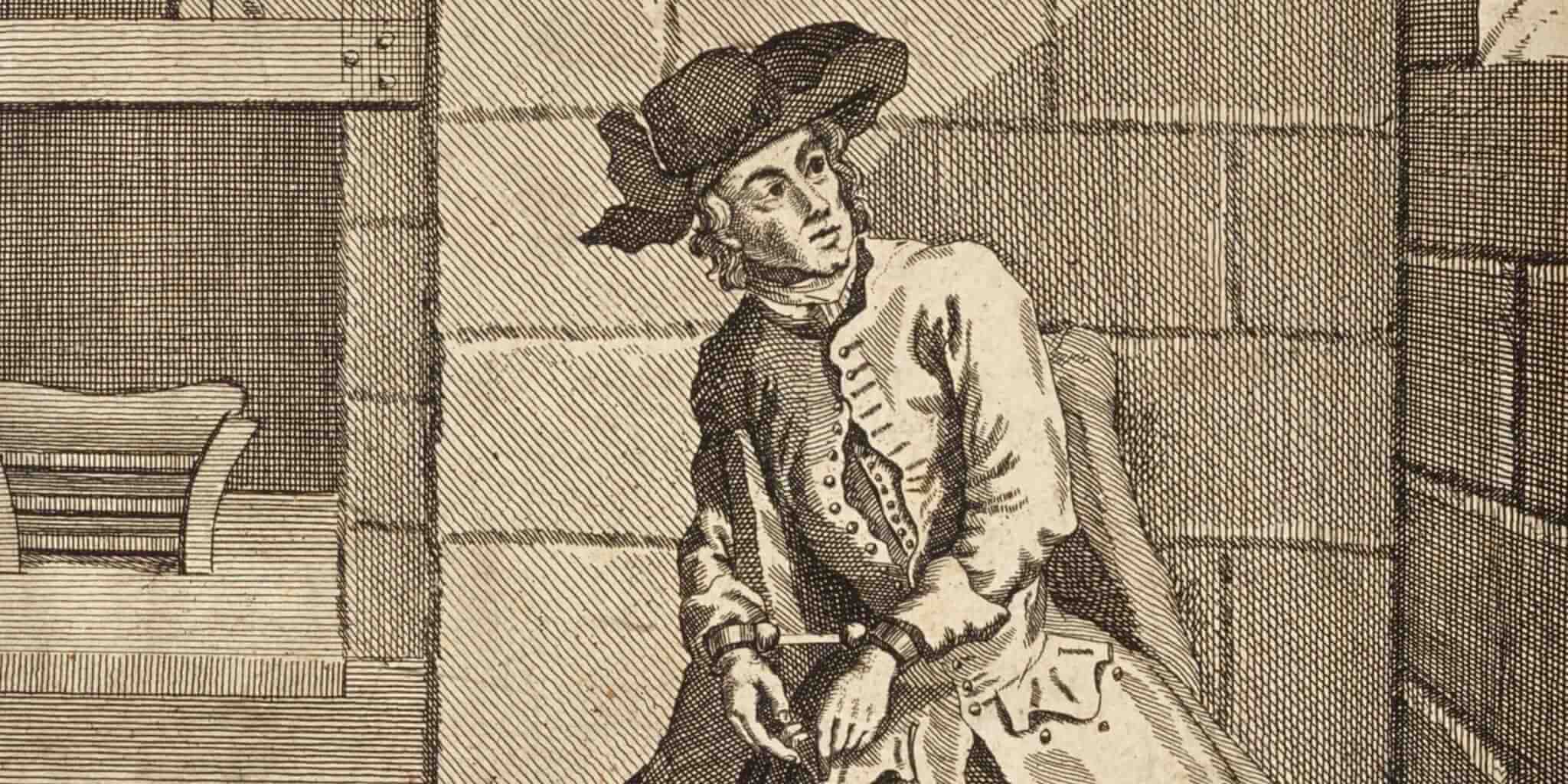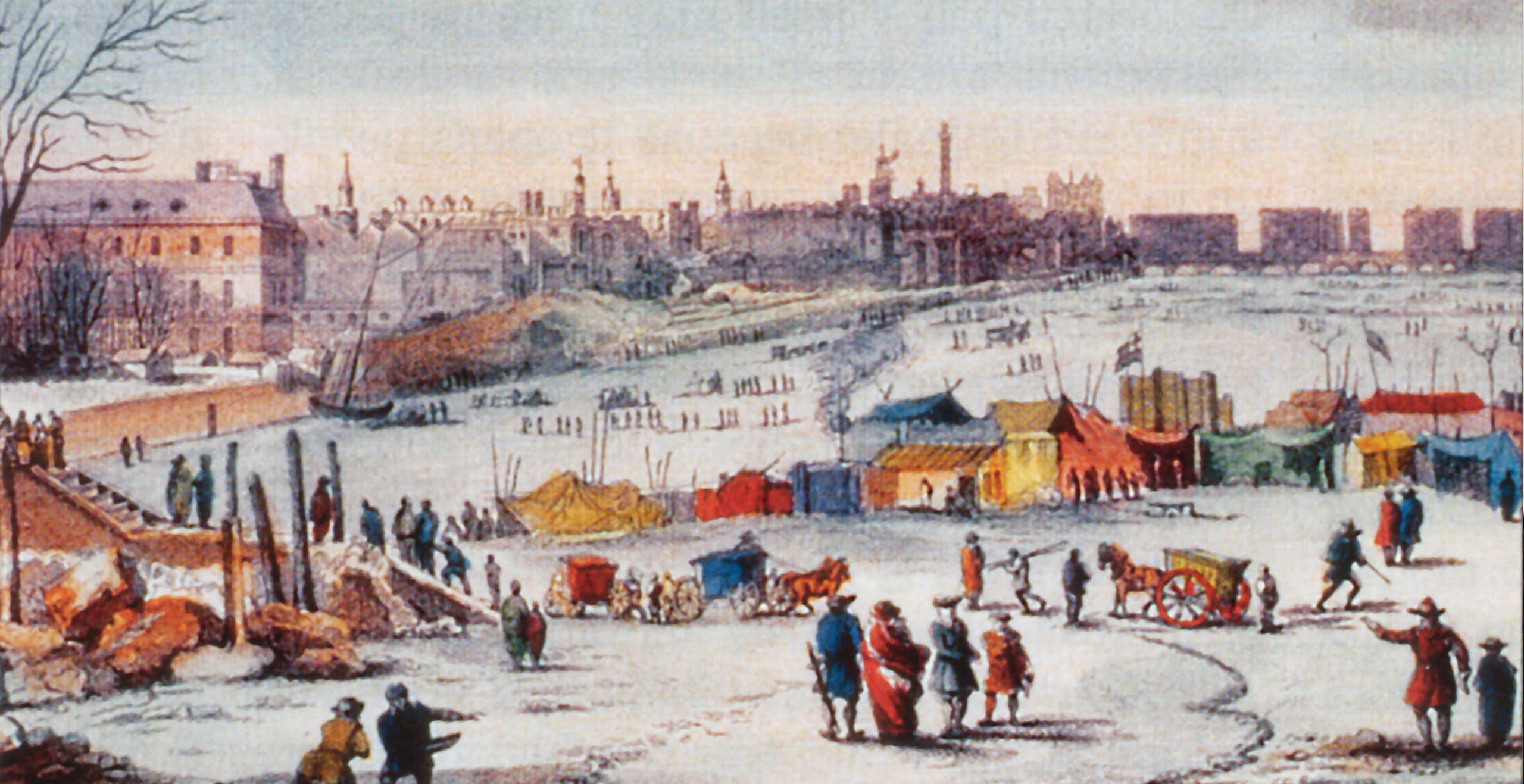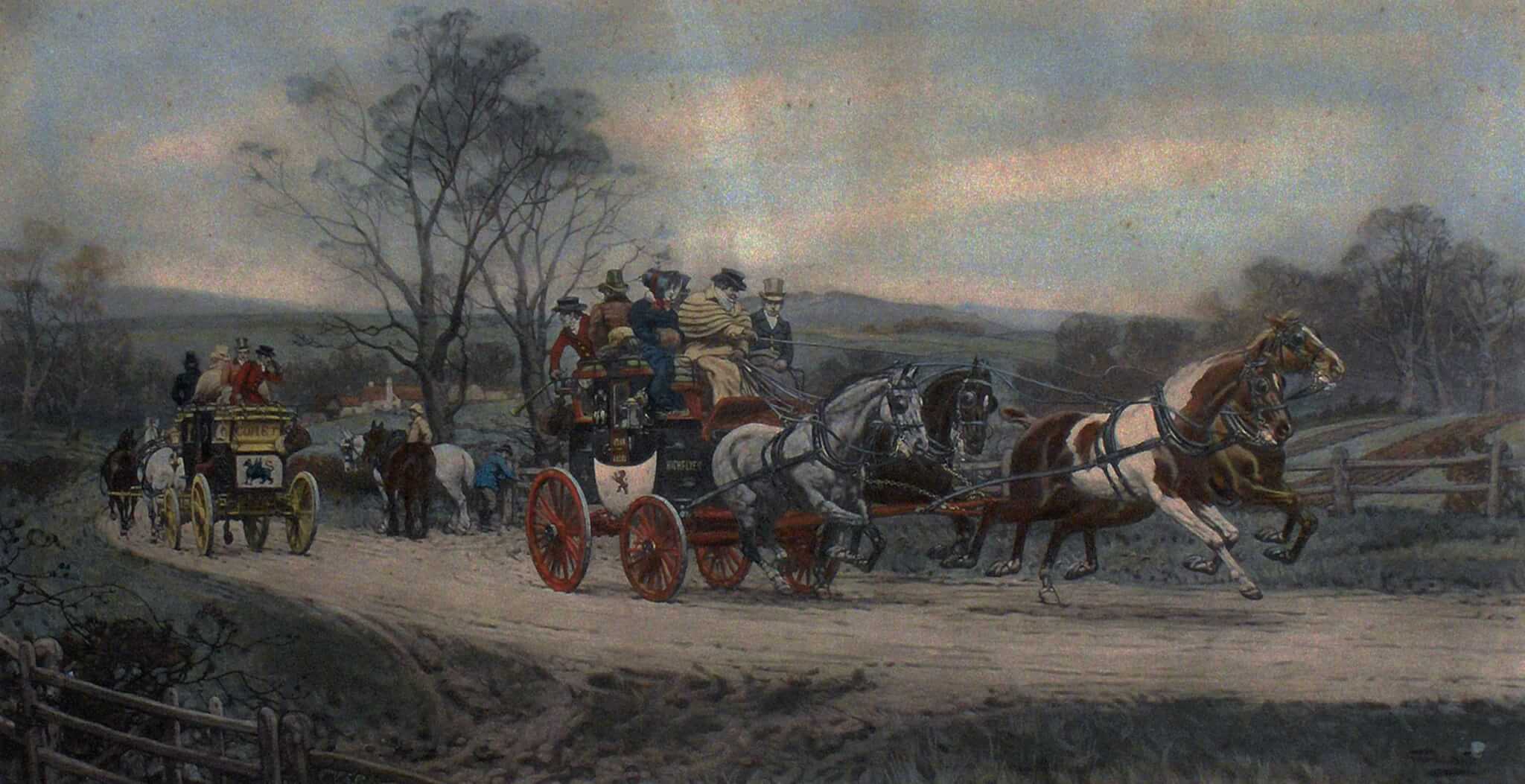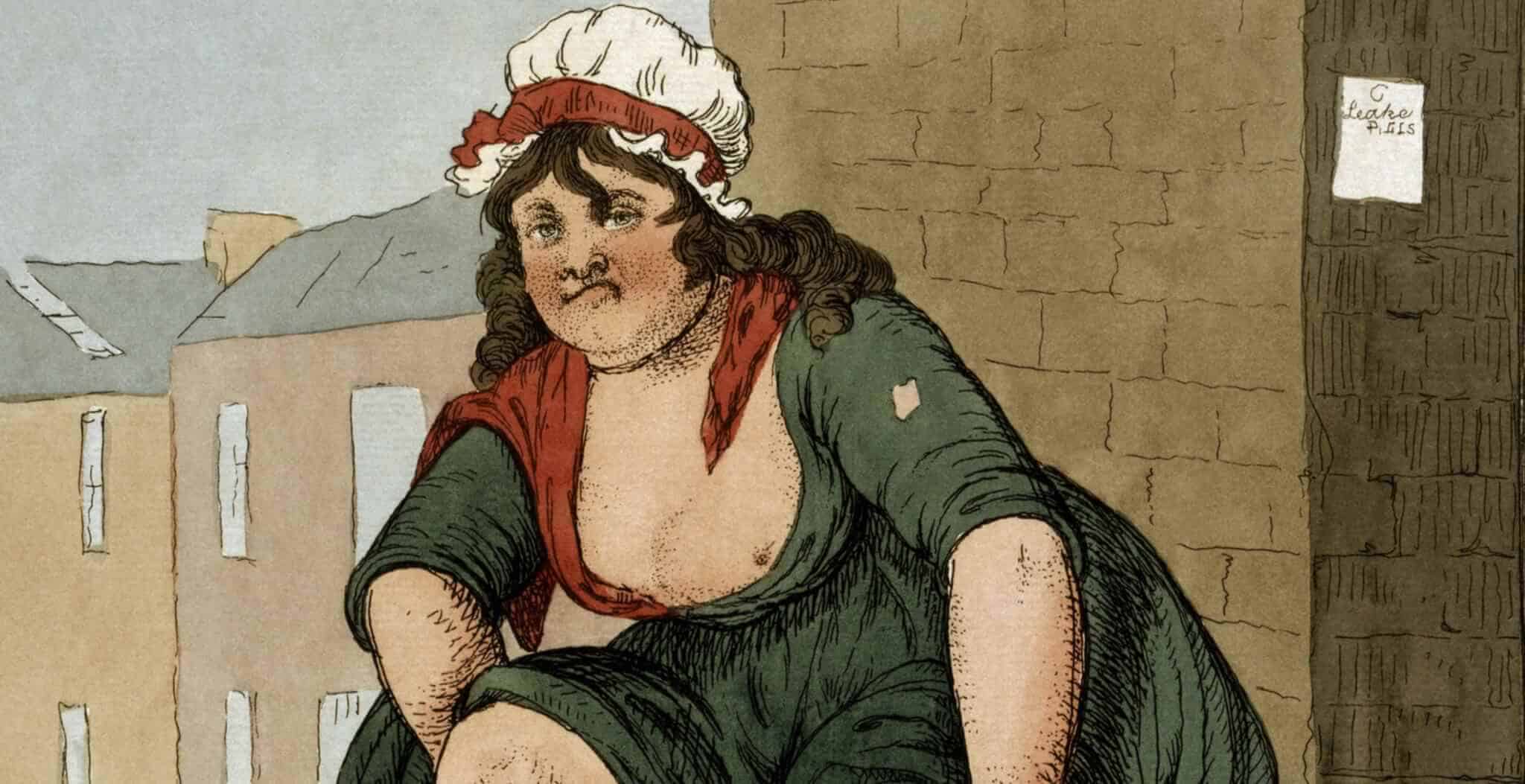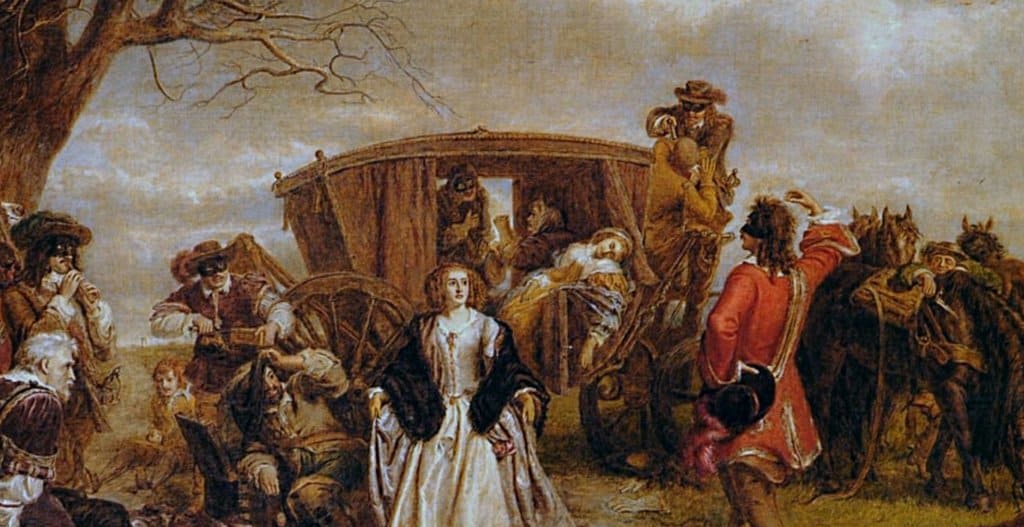Tudor and Stuart London was the natural home of real-life rogues as colourful as any in Shakespeare’s plays. Old St Paul’s Cathedral was the place where they gathered in droves, hoping to find some country innocents to dupe, an activity that was known as coney-catching. Skills that the rogues employed included cutting purses (known in their canting language as “nipping a bung”), various tricks with dropped coins and counterfeit money, and betting scams. They were experts in an extensive range of confidence trickery that still lives on today in recognisable form, albeit updated for the internet age. More villainous rogues simply used violent techniques to rob the unwary, such as a crack on the head with a cudgel, a knife in the ribs or a cut with a sword.
One of the most notorious roguish characters of Jacobean London was Mary Frith, also known as Moll Frith or Moll Cutpurse. Moll’s tall and imposing figure was well-known in the capital as she swaggered her way, dressed in masculine clothing, through the streets of the city. An enthusiastic smoker of tobacco, she was rarely seen without a pipe in one hand. With her would often walk a motley crew of rogues, thieves, highwaymen and her giant mastiff, Wildbrat. “I please myself and care not else who loves me,” her character claims in the play that was written about her, “The Roaring Girl”.
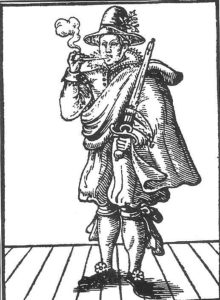
Born in either 1584 or 1589, as accounts vary, Mary Frith was the daughter of a shoemaker in the Barbican. As a young, healthy and strong woman from a humble background, she was more or less doomed to a life of servitude from which she could only escape via marriage. However, Mary soon made clear her forthright views on that, by ignoring convention and preferring to rattle around with the boys, swearing, watching cudgel fights and getting into trouble. If set to sewing or similar pursuits, she would mess it up and throw it aside as quickly as possible to get back onto the streets. One of her biographers described her as “a very Tomrig or Rumpscuttle” who “delighted and sported in boys’ play and pastime”.
After her parents died, Mary quickly learned to take care of herself. She had proved so troublesome to her remaining relatives that they attempted to get rid of her by luring her onto a ship destined for New England. When she discovered how she had been tricked, according to some accounts she jumped overboard before the ship sailed and swam back to shore. From then on, she was on her own, and London’s criminal underworld drew her like a magnet. She adopted male dress permanently, along with a personality and sexuality that kept the world guessing, though she did go through what appears to be a marriage of convenience with a son of the Markham family.
The newly created Moll was soon an adept in the skill of “nipping a bung”, cutting and stealing purses from the girdles of wealthy citizens with her dextrous fingers and disappearing into the crowd before the owners realised their money had gone. She took up the lucrative trade of fortune telling as well. It wasn’t long before she achieved celebrity status in the capital. In 1610, a registry entry in the Stationer’s Company records the publication of “A booke called ‘The madde pranckes of mery Moll of the Banckside, with her walkes in mans apparell, and to what purpose’ by John Day.” This first biography of Moll, when she would have been somewhere in her 20s, is now lost, but it was quickly followed by the first presentation of “The Roaring Girl” by playwrights Middleton and Dekker in 1611.
The “Roaring Boys” were the wild and violent young men of the period whose behaviour was censured by all honest Londoners. Now Moll Cutpurse was the Roaring Girl who could give them a run for their money. The Moll of the play is an articulate, even eloquent young woman who spars as well with her wit as she does with her sword. She hints at her ability to procure people of both sexes, then claims disinterest in the whole topic. The centrepiece of the play is a snappy exchange of terms used by the rogues in their own special language, leaving honest citizens wondering what the heck they are talking about. “The Roaring Girl” plays around with gender identity and sexuality in a way that seems surprisingly modern now, and both followers and critics of Moll couldn’t help being drawn to her immense character.
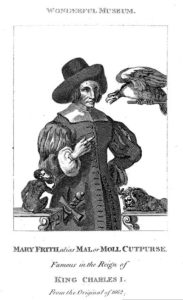
Moll quickly discovered that being a fence (a receiver and exchanger of stolen goods) offered a much safer criminal career than stealing purses. Being Moll, it had to be done in her own unique way, and so she also gained a reputation for generously returning items to the victims if they appealed to her sufficiently. She seems to have had an excellent sense of humour, and her roaring was frequently the sound of peals of laughter. On one occasion, she is said to have been the victim of a merry prankster who partially filled her pipe with gunpowder, and she found this as funny as anyone else.
However, the law caught up with her, along with her celebrity status, when in February 1611 it was announced that Moll Cutpurse, “a notorious baggage that used to go in man’s apparel, and challenge the field of diverse gallants” was doing penance in a sheet at Paul’s Cross for her behaviour. It quickly became clear that the weeping Moll was simply drunk, having “tippel’d of three quarts of sack” before she arrived.
On another occasion, she bet that she would ride astride a horse from Charing Cross to Shoreditch, wearing breeches and doublet, knowing how much this would scandalise the crowd. Just to make sure she had a good audience, she hired a banner and a trumpeter. The crowd responded with shouts of “Come down, thou shame of women, or we will pull thee down!” However, she won her bet, though her claim (made in a posthumous biography) that the horse she rode was the famous performing horse Marocco, and it was his owner William Banks who challenged her to the wager, does not tie in chronologically with the facts.
Moll’s finest criminal hour came when she took to the roads as a highway robber during the years of the Civil War and Commonwealth. Allegedly a committed royalist, she must have taken great satisfaction in the time she held up the Parliamentarian General Fairfax on Hounslow Heath, shooting his servants’ horses and robbing him of 250 gold coins. This was the crime for which she ended in Newgate Prison, from which she is said to have released herself via a very large bribe of £2,000.00!
Towards the end of her life, she spent time in the Bethlem Hospital, the notorious Bedlam where mentally ill people were incarcerated. Moll died in 1659, too early to witness the restoration of her beloved monarchy. According to one account, her epitaph was composed by Milton the poet and included the following lines:
“Here lies under this same marble
Dust for Time’s last sive to garble;
Dust to perplex a Sadducee,
Whether I rise a He or She,
Or two in one a single pair,
Nature’s sport, and now her care…”
A more convincing story reveals that she asked to be buried face down, backside uppermost, in a last defiant gesture to the world. Her many friends and followers undoubtedly mourned her passing, and her legend lived on. Moll Cutpurse appeared in a late 19th century book with the excellent title “Lives of Twelve Bad Women: Illustrations and Reviews of Feminine Turpitude set forth by Impartial Hands”, edited by Arthur Vincent, a title which probably would have amused her greatly.
Miriam Bibby BA MPhil FSA Scot is a historian, Egyptologist and archaeologist with a special interest in equine history. Miriam has worked as a museum curator, university academic, editor and heritage management consultant. She is currently completing her PhD at the University of Glasgow.



